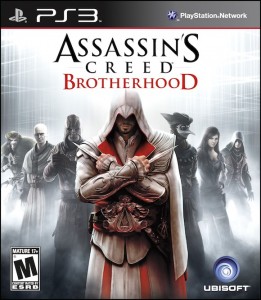Assassin’s Creed: Brotherhood is a beautifully crafted edition to the epic Ubisoft series and is sure to please returning fans-but try not to expect anything groundbreaking.
The third installment of the Assassin’s Creed series picks up right where the second game left off. In the near future, Desmond Miles and the other assassins have narrowly escaped Abstergo and have hidden themselves within the ruins of villa at Monterrigioni. In the past, Ezio Auditore returns to the villa satisfied that his family has been avenged and revels in the fact that he can hang up his assassin hat for good and for all. The momentary peace is shattered when Cesare Borgia brings the fight to his doorstep. Ezio is forced once again to don his cape and venture into the streets of Rome to rebuild the assassin order and overthrow the Borgia regime.
It sounds like an excellent premise. A lone assassin brings together vast networks of mercenaries, thieves, courtesans and assassins to free a city from the tyranny of Cesare Borgia. Unfortunately, the game does not quite deliver on this. There is a point in the game where Ezio is able to recruit fledgling assassins to his cause. Players level recruits by sending them on a variety of missions across the world. In addition to granting recruits experience, these missions bring in a little change and items that can be used in shop quests. The only other role these fledglings play throughout the game is to rain down arrows on the enemy and they can be summoned to assist Ezio during a fight. There is something to be said about having the ability to summon a storm of death from the skies, but it still feels as though this is one aspect of the game the developers could have spent more time with.
The story itself, compared to the first two installments of the series, lacks depth. Aside from a brief episode where a friend is suspected of betraying Ezio, there is little that stands out within the overarching premise of the game. There is little in the way of character development. In Assassin’s Creed II, Ezio undergoes a series of transformations from a plucky teen, to a man out for revenge, to a full-fledged member of the Assassin Order. Brotherhood, on the other hand, throws players into the middle of the action and expects them to sympathize. This is all well and good for someone who has played through the first two games, but newcomers to the series may find themselves shaking their heads in disbelief.
Where this game does deliver is in both the setting and the gameplay. Players explore Rome from the streets and the rooftops. From the light reflecting across the water to the shadows Ezio casts as he leaps from rooftop to rooftop, this game is visually stunning. There is so much to see and plenty of side-missions to keep players engaged in the lush environment. Brotherhood brings back many of the same quests and missions that appear in the first two games. There are feathers, flags, and treasures to collect. There are tombs to explore – though in this incarnation of the game they are called Romulus Lairs. There are the customary courtesan and thief quests. This time around Ezio earns money by upgrading buildings across Rome. He slowly chips away at Borgia power by defeating watchtowers and renovating buildings to generate income.
So, where the plot might be lacking this game certainly makes up for it in the sheer amount of options available to the player. The main plotline can be completed in around 10-15 hours, but players can spend almost double that completing side-missions, upgrading buildings, exploring tombs and immersing themselves in the world of Renaissance Italy. Although not a game that will re-define the Assassin’s Creed experience, Assassin’s Creed: Brotherhood is a fitting continuation to the series.

